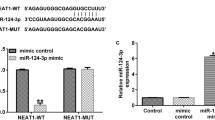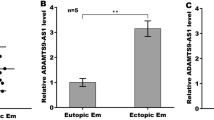Abstract
Considerable efforts have been invested to elucidate the potential mechanisms involved in the physiopathology of endometriosis. However, to date, prior research has not been conclusive. This research has examined one particular mechanism, i.e., the effect of ADAR1 on endometriosis lesions. Eutopic endometrium was collected from women with (n = 25) and without endometriosis (n = 25), respectively. The expression of ADAR1 mRNA was measured based on quantitative real-time polymerase chain reactions (RT-qPCR). Both Western blot and immunohistochemistry were performed to establish ADAR1 protein expression levels. The results indicated that ADAR1 mRNA and proteins were significantly greater in the eutopic endometrium of the women with endometriosis, compared to the women without (P < 0.05). The Cell Counting Kit-8 (CCK-8) and EdU method were conducted to examine the effect of ADAR1 on cell viability and proliferation in eutopic endometriosis cells. A transwell assay was also used to detect the role of ADAR1 in the invasion of endometrial cells. The results obtained showed that ADAR1 promoted endometrial cell viability, proliferation, and invasion (P < 0.05). This informed our conclusion that the ADAR1 gene is upregulated in endometriosis, potentially paying a pivotal role in the physiopathology of endometriosis.




Similar content being viewed by others
References
Jacobson TZ, Barlow DH, Koninckx PR, et al. Laparoscopic surgery for subfertility associated with endometriosis. Cochrane Database Syst Rev. 2002;4:CD001398.
Kumar S, Munkarah A, Arabi H, et al. Prognostic analysis of ovarian cancer associated with endometriosis. Am J Obstet Gynecol. 2011;204(1):63–e1–7.
Munksgaard PS, Blaakaer J. The association between endometriosis and ovarian cancer: a review of histological, genetic and molecular alterations. Gynecol Oncol. 2012;124(1):164–9.
Yamamoto S, Tsuda H, Takano M, et al. PIK3CA mutation is an early event in the development of endometriosis-associated ovarian clear cell adenocarcinoma. J Pathol. 2011;225(2):189–94.
Benagiano G, Brosens I, Habiba M. Structural and molecular features of the endomyometrium in endometriosis and adenomyosis. Hum Reprod Update. 2014;20(3):386–402.
Ulukus M, Cakmak H, Arici A. The role of endometrium in endometriosis. J Soc Gynecol Investig. 2006;13(7):467–76.
Maia HJ, Haddad C, Coelho G, Casoy J. Role of inflammation and aromatase expression in the eutopic endometrium and its relationship with the development of endometriosis. Women’s Health (Lond). 2012;8(6):647–58.
Colette S, Lousse JC, Defrere S, et al. Absence of aromatase protein and mRNA expression in endometriosis. Hum Reprod. 2009;24(9):2133–41.
Wang F, Wen Z, Li H, et al. Human leukocyte antigen-G is expressed by the eutopic and ectopic endometrium of adenomyosis. Fertil Steril. 2008;90(5):1599–604.
Reenan RA. Molecular determinants and guided evolution of species-specific RNA editing. Nature. 2005;434(7031):409–13.
Valente L, Nishikura K. ADAR gene family and A-to-I RNA editing: diverse roles in posttranscriptional gene regulation. Prog Nucleic Acid Res Mol Biol. 2005;79:299–338.
Athanasiadis A, Rich A, Maas S. Widespread A-to-I RNA editing of Alu-containing mRNAs in the human transcriptome. PLoS Biol. 2004;2(12):e391.
Li JB, Levanon EY, Yoon JK, Aach J, Xie B, Leproust E, et al. Genome-wide identification of human RNA editing sites by parallel DNA capturing and sequencing. Science. 2009;324(5931):1210–3.
Nishikura K. Functions and regulation of RNA editing by ADAR deaminases. Annu Rev Biochem. 2010;79:321–49.
Nemlich Y, Greenberg E, Ortenberg R, Besser MJ, Barshack I, Jacob-Hirsch J, et al. MicroRNA-mediated loss of ADAR1 in metastatic melanoma promotes tumor growth. J Clin Invest. 2013;123(6):2703–18.
Knuutila S, Bjorkqvist AM, Autio K, et al. DNA copy number amplifications in human neoplasms: review of comparative genomic hybridization studies. Am J Pathol. 1998;152(5):1107–23.
Patterson JB, Samuel CE. Expression and regulation by interferon of a double-stranded-RNA-specific adenosine deaminase from human cells: evidence for two forms of the deaminase. Mol Cell Biol. 1995;15(10):5376–88.
George CX, Samuel CE. Human RNA-specific adenosine deaminase ADAR1 transcripts possess alternative exon 1 structures that initiate from different promoters, one constitutively active and the other interferon inducible. Proc Natl Acad Sci U S A. 1999;96(8):4621–6.
Chen L, Li Y, Lin CH, Chan TH, Chow RK, Song Y, et al. Recoding RNA editing of AZIN1 predisposes to hepatocellular carcinoma. Nat Med. 2013;19(2):209–16.
Qin YR, Qiao JJ, Chan TH, et al. Adenosine-to-inosine RNA editing mediated by ADARs in esophageal squamous cell carcinoma. Cancer Res. 2014;74(3):840–51.
Hu X, Chen J, Shi X, Feng F, Lau KW, Chen Y, et al. RNA editing of AZIN1 induces the malignant progression of non-small-cell lung cancers. Tumour Biol. 2017;39(8):1010428317700001.
Chen Y, Wang H, Lin W, Shuai P. ADAR1 overexpression is associated with cervical cancer progression and angiogenesis. Diagn Pathol. 2017;12(1):12.
Shigeyasu K, Okugawa Y, Toden S, et al. AZIN1 RNA editing confers cancer stemness and enhances oncogenic potential in colorectal cancer. JCI Insight 2018; 3(12).
Teoh PJ, An O, Chung TH, et al. Aberrant hyperediting of the myeloma transcriptome by ADAR1 confers oncogenicity and is a marker of poor prognosis. Blood. 2018;132(12):1304–17.
Chan TH, Lin CH, Qi L, Fei J, Li Y, Yong KJ, et al. A disrupted RNA editing balance mediated by ADARs (adenosine deaminases that act on RNA) in human hepatocellular carcinoma. Gut. 2014;63(5):832–43.
Revised American Society for Reproductive Medicine. classification of endometriosis. Fertil Steril 1997. 1996;67(5):817–21.
Masuda A, Katoh N, Nakabayashi K, Kato K, Sonoda K, Kitade M, et al. An improved method for isolation of epithelial and stromal cells from the human endometrium. J Reprod Dev. 2016;62(2):213–8.
Pantschenko AG, Barber MR, Woodcock-Mitchell J, Bushmich SL, Yang TJ. Establishment and characterization of a caprine mammary myoepithelial cell line (CMMyoEC). In Vitro Cell Dev Biol Anim. 2000;36(6):351–6.
Vu TH, Werb Z. Matrix metalloproteinases: effectors of development and normal physiology. Genes Dev. 2000;14(17):2123–33.
Roy R, Yang J, Moses MA. Matrix metalloproteinases as novel biomarkers and potential therapeutic targets in human cancer. J Clin Oncol. 2009;27(31):5287–97.
Frankowski H, Gu YH, Heo JH, Milner R, del Zoppo G. Use of gel zymography to examine matrix metalloproteinase (gelatinase) expression in brain tissue or in primary glial cultures. Methods Mol Biol. 2012;814:221–33.
Zhang J, Chen Z, Tang Z, Huang J, Hu X, He J. RNA editing is induced by type I interferon in esophageal squamous cell carcinoma. Tumour Biol. 2017;39(7):1010428317708546.
Anadon C, Guil S, Simo-Riudalbas L, et al. Gene amplification-associated overexpression of the RNA editing enzyme ADAR1 enhances human lung tumorigenesis. Oncogene. 2016;35(33):4422.
Chan TH, Qamra A, Tan KT, et al. ADAR-Mediated RNA Editing Predicts Progression and Prognosis of Gastric Cancer. Gastroenterology 2016; 151(4):637–650.e10.
Saare M, Lamp M, Kaart T, Karro H, Kadastik U, Metspalu A, et al. Polymorphisms in MMP-2 and MMP-9 promoter regions are associated with endometriosis. Fertil Steril. 2010;94(4):1560–3.
Yang M, Jiang C, Chen H, et al. The involvement of osteopontin and matrix metalloproteinase- 9 in the migration of endometrial epithelial cells in patients with endometriosis. Reprod Biol Endocrinol. 2015;13:95.
Hu X, Wan S, Ou Y, Zhou B, Zhu J, Yi X, et al. RNA over-editing of BLCAP contributes to hepatocarcinogenesis identified by whole-genome and transcriptome sequencing. Cancer Lett. 2015;357(2):510–9.
Galeano F, Leroy A, Rossetti C, Gromova I, Gautier P, Keegan LP, et al. Human BLCAP transcript: new editing events in normal and cancerous tissues. Int J Cancer. 2010;127(1):127–37.
Amin EM, Liu Y, Deng S, et al. The RNA-editing enzyme ADAR promotes lung adenocarcinoma migration and invasion by stabilizing FAK. Sci Signal. 2017:10(497).
Funding
The author(s) declared the following potential conflicts of interest with respect to the research, authorship, and/or publication of this article: This work was supported by the Henan Science and Technology Research Project of China. The work was also supported by the Department of Obstetrics and Gynecology of the Third Affiliated Hospital of Zhengzhou University.
Author information
Authors and Affiliations
Corresponding author
Ethics declarations
Conflict of Interest
The author(s) declared no potential conflicts of interest with respect to the research, authorship, and/or publication of this article.
Rights and permissions
About this article
Cite this article
Li, Z., Qi, R., Wang, Q. et al. Aberrant Overexpression of RNA-Editing Enzyme ADAR1 Promotes the Progression of Endometriosis. Reprod. Sci. 27, 575–584 (2020). https://doi.org/10.1007/s43032-019-00057-w
Received:
Accepted:
Published:
Issue Date:
DOI: https://doi.org/10.1007/s43032-019-00057-w




